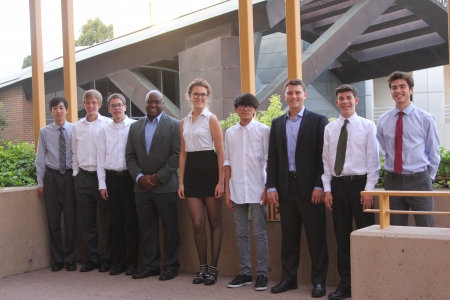High School Students Gain Research Experience through Internship Program
Samueli School Dean Gregory Washington was on hand for project presentations by the St. Margaret's High School summer interns.
Now in its 12th year, the program matches high-potential students with an engineering faculty member and research area based on their interests. Spearheaded by Engineering Leadership Council member Stacey Nicholas, the program aims to inspire enthusiasm for STEM fields with the hope that the high school students will pursue these areas as they move forward in their education and careers. Along with university-level engineering research experience, the students also receive university credit to add to their college applications.
The six-week internship program accepts five to 10 students each summer. Over the years, admission – based on students’ GPAs and academic merits – has become increasingly competitive. This year’s group gathered last month to present their design projects to their families, faculty and graduate student mentors.
Michelle Digman, assistant professor in biomedical engineering, advised two of the students and thought it went really well. “Both students were excellent,” she said. “They had the desire to learn something from this experience and were committed to finishing their projects.”
In the Digman lab, Will Rosenthal’s project was to develop an inexpensive electronic circuit and an early screening method for Huntington’s Disease. Michael Rubenacker tested and analyzed autofluorescence in cells at different confluency stages.
Scott Samuelsen, professor emeritus and director of the National Fuel Cell Research Center, also advised two students. Katherine Adelman conducted a solar PV and load analysis of UCI’s Microgrid, and Jack Westhead investigated the impact of fuel variability in the natural gas system on emissions and air quality.
Two students interned in the lab of David Reinkensmeyer, professor of mechanical and aerospace engineering. Joshua Ong’s project involved developing a low-cost pneumatic flight simulator chair for consumer use. Charlie Smith designed an easy-to-use, affordable and 3-D printable phone case to assist patients in thumb rehabilitation.
Working with Brian Demsky, associate professor of electrical engineering and computer science, Thomas Kwa looked at phone localization and cloud projects related to the Internet of Things.
Rose McCarver investigated ways to improve the corrosion resistance of gas turbine engines under the guidance of Daniel Mumm, associate professor of chemical engineering and materials science.
James Swanson worked with Russ Detwiler, associate professor of civil and environmental engineering, to create an apparatus that can quantify tracer concentrations within a fluid transport system.
Digman noted that the students had a great fundamental understanding in physics, chemistry and biology. “Overall this is mostly what is needed to start to understand advanced topics.”
